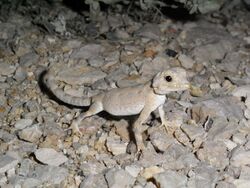Biology:Pristurus carteri
| Pristurus carteri | |
|---|---|

| |
| Scientific classification | |
| Domain: | Eukaryota |
| Kingdom: | Animalia |
| Phylum: | Chordata |
| Class: | Reptilia |
| Order: | Squamata |
| Family: | Sphaerodactylidae |
| Genus: | Pristurus |
| Species: | P. carteri
|
| Binomial name | |
| Pristurus carteri (Gray, 1863)[2]
| |
| Synonyms[3] | |
| |
Pristurus carteri, commonly known as Carter's rock gecko or Carter's semaphore gecko, is a species of gecko, a lizard in the family Sphaerodactylidae.
Etymology
The generic name, Pristurus, means "saw-tailed" in Latin.[citation needed]
The specific name, carteri, is in honor of Dr. Henry Carter who collected the holotype.[4]
Subspecies
There are two subspecies of Pristurus carteri. The first is the nominotypical subspecies, Pristurus carteri carteri (Gray, 1863), and the other is Pristurus carteri tuberculatus Parker, 1931,[3] P. c. carteri being the more common.[citation needed]
Common names
The species P. carteri has many common names such as Carter's rock gecko, ornate rock gecko, and scorpion-tailed gecko.[citation needed]
Geographic range and habitat
P. carteri is native to Oman, Saudi Arabia, United Arab Emirates, and Yemen,[3] where it often is found basking on rocks or in urban areas.[citation needed]
Behavior
P. carteri are often seen swaying their curly tails back and forth to each other in a way to sort of communicate to each other. The males develop little fleshy spikes on their tails upon reaching sexual maturity. When they feel threatened they curl their tails in a scorpion-like fashion and even mimic the movements a scorpion will use as a threat display; this and the tail waving are the source of the common name scorpion-tailed geckos.[citation needed]
Members of the genus Pristurus are diurnal. This is unusual in geckos except in the genera Phelsuma, Lygodactylus, Naultinus, Quedenfeldtia, Rhoptropus, all Sphaerodactylids, and, of course, Pristurus.[5]
Description
P. carteri may attain an average snout-to-vent length (SVL) of 5–6 cm (2.0–2.4 in), and a total length (including tail) of 8–9 cm (3.1–3.5 in).[citation needed]
Reproduction
P. carteri reaches sexual maturity in roughly 10 months. Adult females lay 1–2 hard shelled eggs that are incubated at 28 °C (82.4 °F) for 70–90 days. Each neonate hatches out at a total length of about 3.5–4 cm (1.4–1.6 in).[citation needed]
References
- ↑ Sindaco R, Wilms T, Mohammed SF (2012). "Pristurus carteri ". The IUCN Red List of Threatened Species 2012: e.T199586A2605065. https://doi.org/10.2305/IUCN.UK.2012.RLTS.T199586A2605065.en. Downloaded on 21 February 2019.
- ↑ "Pristurus carteri ". ITIS (Integrated Taxonomic Information System). www.itis.gov.
- ↑ 3.0 3.1 3.2 Species Pristurus carteri at The Reptile Database www.reptile-database.org.
- ↑ Beolens, Bo; Watkins, Michael; Grayson, Michael (2011). The Eponym Dictionary of Reptiles. Baltimore, Maryland: Johns Hopkins University Press. xiii + 296 pp. ISBN:978-1-4214-0135-5. (Pristurus carteri, p. 49).
- ↑ Pianka ER, Vitt LJ (2003). Lizards: Windows to the Evolution of Diversity. Berkeley, California: University of California Press. 346 pp. ISBN:978-0520234017. (Genus Pristurus, pp. 174, 179).
Further reading
- Boulenger GA (1885). Catalogue of the Lizards in the British Museum (Natural History). Second Edition. Volume I. Geckonidæ ... London: Trustees of the British Museum (Natural History). (Taylor and Francis, printers). xii + 436 pp. + Plates I-XXXII. (Pristurus carteri, pp. 55–56).
- Gray JE (1863). "Description of a New Lizard obtained by Mr. Henry Carter on the South-east Coast of Arabia". Proc. Zool. Soc. London 1863: 236-237 + Plate XX, figure 2. (Spatalura carteri, new species).
- Parker HW (1931). "Some Reptiles and Amphibians from S.E. Arabia". Ann. Mag. Nat. Hist., Tenth Series 8: 514–522. (Pristurus carteri tuberculatus, new subspecies).
Wikidata ☰ Q3062040 entry
 |


